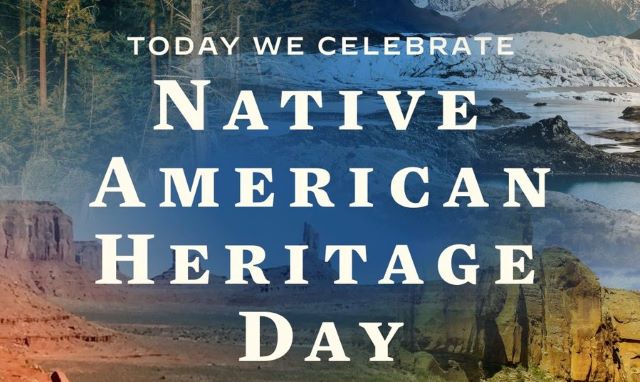
In celebration of Native American Heritage Day, SACNAS shared a post on social media honoring “the rich histories, enduring resilience, and invaluable contributions of Native communities.”
Native American Heritage Day, observed on Friday, November 29, concludes the month-long celebration of Native American Heritage Month.
Throughout November, the American Indian Higher Education Consortium hosted a Q&A on social media.
Today’s question was on the number of tribal colleges and universities that offer Native language courses. November 19th’s question was on how much funding the Indian Student Count (ISC) formula allocate per full-time enrolled Native student.
President Biden highlighted the significance of Indigenous peoples’ history in the United States, which is characterized by strength, survival, and a deep commitment to their heritage, self-governance, and ways of life, in his 2024 Native American Heritage Day proclamation.
“Native peoples have built and sustained powerful Tribal Nations, and the knowledge they have developed continues to benefit us,” Biden stated.
Recent data from the Census Bureau indicates that over half (50.9%) of the American Indian population resides in just five states.
As of today, Oklahoma has the largest American Indian population at 14.2%, followed by Arizona (12.9%), California (9.9%), New Mexico (9.1%), and Texas (4.8%). From 2010 to 2020, the population of American Indians alone grew by 11.6%, reaching 2,159,802.
Meanwhile, the combined population of those identifying as American Indian alone or in any combination nearly doubled, rising to 6,363,796.
The Latin American Indian alone population surged 344.7% to 766,112, while the Latin American Indian alone or in any combination population increased by 390.4% to 1,319,523.
The Alaska Native alone population grew by 10.9% to 133,311, and the Alaska Native alone or in any combination population rose by 45.6% to 241,797.
Furthermore, the Canadian Indian alone population increased by 20.0% to 7,723, while the alone or in any combination population soared 390.4% to 72,701, marking an increase more than 19 times larger than that of the alone population.
The Navajo Nation accounts for the largest share of the American Indian alone population at 14.6%, followed by the Cherokee (10.0%), Choctaw (3.2%), and the Lumbee Tribe of North Carolina (2.5%).
In terms of the American Indian population alone or in any combination, the Cherokee holds the largest share at 23.8%, followed by the Navajo Nation (6.7%), the Blackfeet Tribe of the Blackfeet Indian Reservation of Montana (4.7%), and the Choctaw (4.0%).
Also, the Aztecs and Maya, newly included in the AIAN category in the 2020 Census, represent 74.0% of the Latin American Indian alone population and 67.1% of the Latin American Indian alone or in any combination population.
Mexican Indians (Aztec and Mexican Indian) comprise over half (52.5%) of the Latin American Indians alone and 46.8% of all Latin American Indians alone or in any combination populations.
According to the American Indian Higher Education Consortium, 35 accredited Tribal Colleges and Universities (TCUs) serve students from over 250 federally recognized Indian tribes.
Navajo Technical University (NTU) offers 40 STEM programs and three graduate degrees in engineering and technology.
This fall, NTU honored several individuals for their dedication and commitment to its engineering alumni, faculty, and advisory board members at an accreditation ceremony held on campus.
Accreditation ensures that students in NTU’s engineering and technology programs meet industry standards necessary for careers in STEM fields.
Honorees included an alumna and former president of the Engineering Club, faculty members from various engineering disciplines, and graduates in industrial engineering and information technology.
The event also showcased NTU’s electrical and industrial engineering programs, both accredited by the Accreditation Board for Engineering and Technology (ABET).
During the ceremony, Dr. Elmer Guy emphasized that the Industrial Engineering program has established a foundation for a fabrication lab, noting that students are making significant strides in STEM by collaborating with organizations such as NASA, Sandia Labs, and the National Science Foundation.
“Our board is incredibly supportive and believes in our vision. We are excited to expand Ph.D. programs in engineering at NTU, which will enhance student retention and success,” Dr. Guy stated.
Dr. Andy Nez, a delegate from the Navajo Nation Council, congratulated President Guy, the Board of Regents, and all those involved in securing accreditation for additional bachelor’s and associate degree programs.
In her remarks, Dr. Colleen Bowman expressed gratitude to the faculty for their commitment to the university and acknowledged the partners who go above and beyond to provide opportunities for the Navajo community.
The U.S. Army Corps of Engineers has been tasked with…
Brown and Caldwell, a leading environmental engineering and construction firm,…
Humboldt State University, one of four campuses within the California…